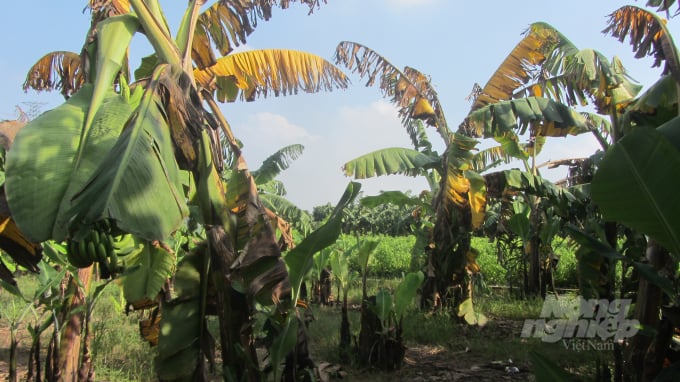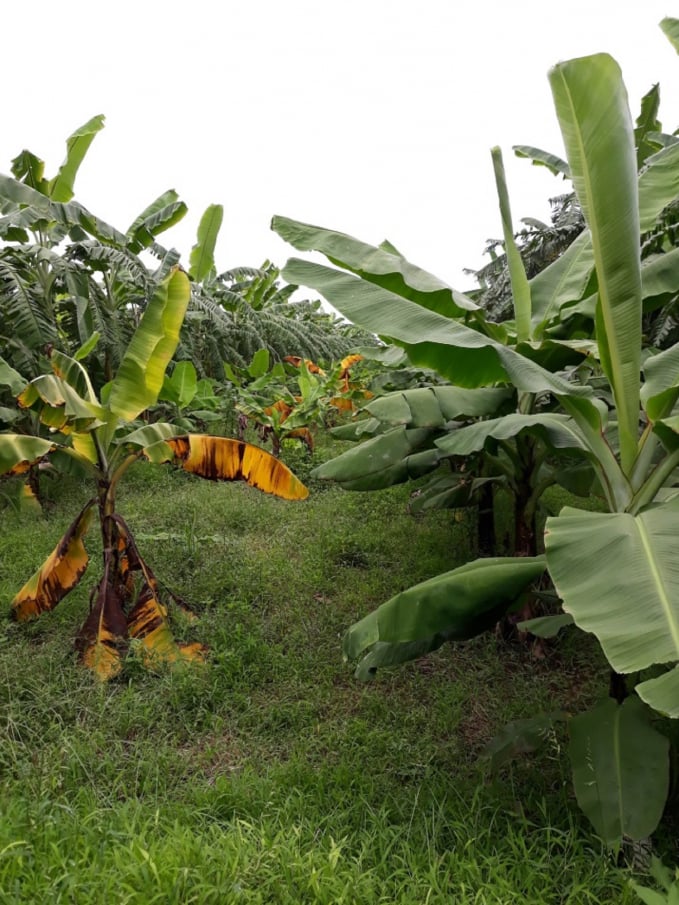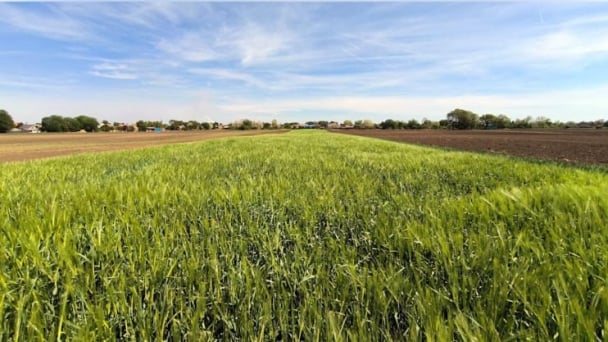June 19, 2025 | 12:10 GMT +7
June 19, 2025 | 12:10 GMT +7
Hotline: 0913.378.918
June 19, 2025 | 12:10 GMT +7
Hotline: 0913.378.918
On November 16, the Vietnam Agriculture Newspaper published an article titled ‘Khoai Chau Banana Barn in Danger of Being ‘obliterated’” reflecting the situation of banana and pepper in Khoai Chau District (Hung Yen Province) which has suffered from yellow leaf disease for recent years causing a sharp decrease in the number of growing areas.
Speaking about the issue, Mr. Nguyen Quy Duong, Deputy Director of the Plant Protection Department said the banana leaf wilt disease has been recorded in some provinces and cities such as Hanoi, Phu Tho, Lao Cai and Hung Yen...

Mr. Nguyen Quy Duong, Deputy Director of the Plant Protection Department. Photo: Duc Minh.
To proactively prevent such disease, based on the results of an investigation project supported by FAO, the Plant Protection Department (PPD) has coordinated with the Research Institute of Fruits and Vegetables and the Institute of Plant Protection to develop and issue an integrated Management Regulation on banana leaf yellow wilt disease.
According to Mr. Nguyen Quy Duong, in 2020, the PPD established a working group soon to survey the actual situation of the disease. Through a survey on more than 10,000 hectares of bananas in the North, the group found banana leaf wilt disease tends to cause strong damage on riverside areas.
Infected banana plants usually had yellow leaves from the old below, then gradually spread to the young. The yellow symptom develops from the leaf margin and spreads into the vein. Infected leaves often turn to wilt with broken stems and leaves hung on the false stem. Sometimes, the petiole is also broken in the middle of the leaf blade.
On infected plants, the old leaves are wilted around the pseudo-stem. Only a few green buds can grow upwards but they are pale or rather yellowish then also turn to be distorted, wrinkled, and finally wilted.
The yellow wilt disease in banana leaves appears and causes damage mainly in areas that grow bananas for 3 years or more. In perennial areas, the rate of infected plants is higher. The disease can develop and cause damage during any stage of growth. It is most evident in the flowering and fruiting stages.

Some banana orchards are severely infected with yellow leaf disease in Tu Dan Commune (Khoai Chau District, Hung Yen Province). Photo: H.Tien.
Some localities could not completely handle this disease even though they changed to use from inorganic into organic and micro-organic fertilizers. Some even bought tissue seedlings for planting. Mr. Duong explained it is because farmers have not thoroughly handled the pathogen.
"Banana leaf yellow wilt is a gradual fatal disease of banana plants caused by fungi that invade, grow and cause damage in the vessels. When the infected banana plants die, spores (reproductive organs of the diseased fungus) are released into the soil. They germinate and penetrate into the cells of other banana roots, then develop into a mycelium that later damages the roots," said Mr. Duong.
The yellow wilt disease of banana leaf, also known as Panama wilt disease, is caused by the fungus Fusarium oxysporum f. sp. cubense (Foc). Fusarium oxysporum is a multiphasic fungus that damages many crops such as cotton, flax, tomato, cabbage, peas, sweet potato, watermelon, oil palm and banana...
To date, Foc has been classified into three strains of Foc Race 1 (Foc 1), Foc Race 2 (Foc 2) and Foc Race 4 (Foc 4). Basing on the banana variety, the fungus uses it as a host. Among the three strains, Foc 4 can be divided into two smaller strains, namely Tropical Foc 4 (Foc TR4) and Subtropical Foc 4 (Foc STR4). The harmful strain on bananas in some provinces is currently TR4.
The TR4 strain has a wider host range and better survival to spread.
Mr. Duong also affirmed that currently, there are many guidelines to handle such a disease. In view of agro-ecology, the DPP has developed measures based on integrated crop health improvement (IPHM). In which, the Department emphasizes "prevention is key".
To prevent the disease, the PPD recommends farmers choose good varieties with high resistance against it. One of them is the GL3-5 variety developed by the Fruit and Vegetable Research Institute. This variety is now growing well in areas that have been infected before with yellow wilt disease of banana leaves.

Currently, the Research Institute of Fruits and Vegetables has researched and successfully produced banana varieties that are very highly resistant to banana leaf wilt disease (right row is disease-resistant banana variety GL3-5 and the opposite is the one infected with the disease). Photo: Favri.
Besides selecting varieties, the PPD recommends farmers strictly follow the cultivation process. For example, when entering a banana garden suspected of being infected, or returning from a suspected infected area, people need to put plastic bags on their shoes, sandals, and boots.
When selecting, breeding, and propagating, people do not use seedlings with separated shoots from infected banana gardens.
In infected areas, growers should destroy all infected plants, including stems, leaves, banana tubers, and residues according to the process guided by the PPD. Particularly for the soil treatment process, it is necessary to sprinkle the lime powder into the planting hole or prepare with antifungal elements.
For severely infected areas, it is suggested to rotate crops with some other crops, for example, maize and peanuts in the flat land. After about 2-3 years, farmers can replant bananas.
Farmers in areas where has not been infected with the disease should absolutely avoid going to the infected because harmful fungi can follow the soil and water on their shoes, sandals, and clothes. They must also strictly control the entry and exit by using disinfect farming tools to prevent the penetration of disease sources.
Mr. Le Minh Nam, Deputy Director of Hung Yen sub-PPD, said that the provincial sub-department is currently coordinating with the PPD and relevant units to propagate and raise farmers’ awareness since the stage of selecting seed, planting, as well as disease treatment.
One of the key tasks of Hung Yen sub-PPD is the application of IPM (or IPHM) solutions in the management of issues from plant health, soil health, to sustainable farming so that to ensure the efficiency of banana growing in particular, and other crops in general.
Translated by Van Trang
![Turning wind and rain into action: [9] Digitizing hydrometeorological data in response to climate change](https://t.ex-cdn.com/nongnghiepmoitruong.vn/608w/files/news/2025/06/17/z6704423696987_15fd32ffc26d590d204d520c9dac6786-nongnghiep-165943.jpg)
(VAN) Farmers have begun accessing hydrometeorological applications to adjust their cropping schedules, aiming to ensure productivity and adapt to climate change.
![Turning wind and rain into action: [8] Real-time salinity detection and early warning technology](https://t.ex-cdn.com/nongnghiepmoitruong.vn/608w/files/news/2025/06/17/z6704423696987_15fd32ffc26d590d204d520c9dac6786-nongnghiep-151127.jpg)
(VAN) Thanks to the integration of modern hydrological-hydraulic models, remote sensing technologies, and artificial intelligence, the accuracy of hydrological forecasting has significantly improved.
![Turning wind and rain into action: [7] Early disaster warnings help marine farmers minimize losses](https://t.ex-cdn.com/nongnghiepmoitruong.vn/608w/files/news/2025/06/17/z6704423696987_15fd32ffc26d590d204d520c9dac6786-nongnghiep-142942.jpg)
(VAN) In recent years, thanks to early disaster warnings and forecasting, marine farmers in Khanh Hoa province have been able to reduce risks and losses, thereby improving production efficiency.
![Turning wind and rain into action: [6] ‘Four on-the-spot’ disaster management software](https://t.ex-cdn.com/nongnghiepmoitruong.vn/608w/files/news/2025/06/17/e5a48259d6a262fc3bb3-nongnghiep-183800.jpg)
(VAN) By simply activating the scenario on the disaster management software, the relevant authorities immediately know how many households need to be evacuated, where to evacuate them to, and by what means of transportation…
![Turning wind and rain into action: [5] Hue applies modern technology in disaster forecasting](https://t.ex-cdn.com/nongnghiepmoitruong.vn/608w/files/news/2025/06/17/z6704423696987_15fd32ffc26d590d204d520c9dac6786-nongnghiep-093938.jpg)
(VAN) In Hue city, modern technology has recently been applied in meteorological and hydrological forecasting and warning, helping to reduce the damage caused by natural disasters.

(VAN) A cutting-edge farming technique being implemented on an experimental ranch in Arizona's Sonoran Desert has already saved a billion gallons of water over five years, according to Civil Eats.

(VAN) Poultry and pig production and the environment can be boosted through enhanced water technology, according to new research.